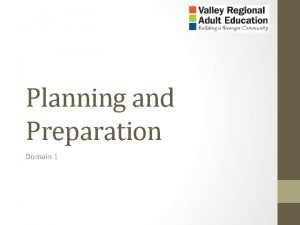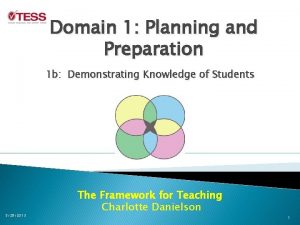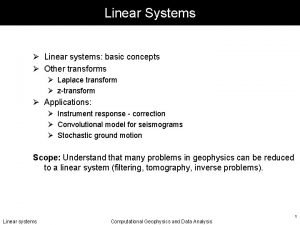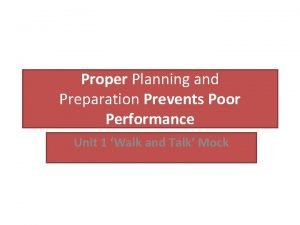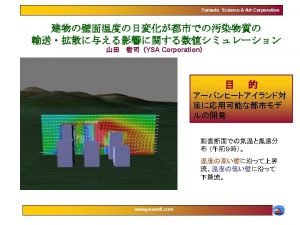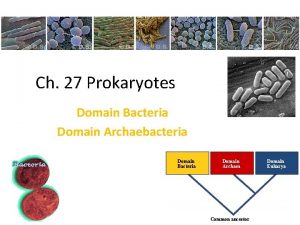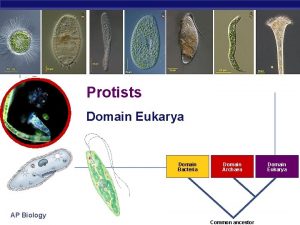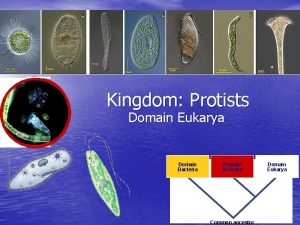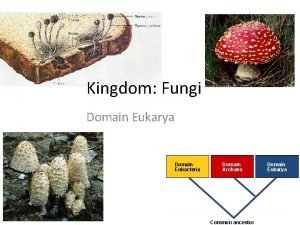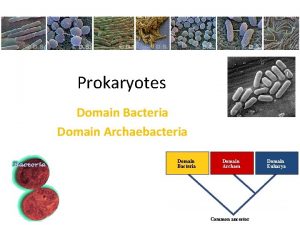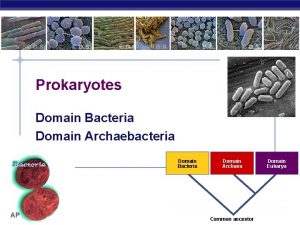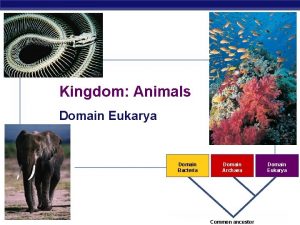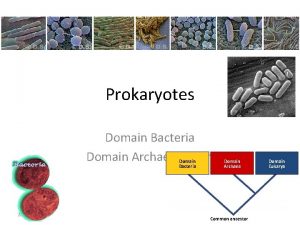Planning and Preparation Domain 1 Planning and Preparation
















- Slides: 16

Planning and Preparation Domain 1

Planning and Preparation • How do you demonstrate your knowledge of your content, students, and resources? • How do you document your instructional outcomes? • How do you illustrate your instruction and assessment to others? • Why do you need to demonstrate, document and illustrate your work? • Activity One – Your own experiences/share out

Planning • Planning is the essential beginning for every lesson. The purpose of each lesson is to ensure that students learn. This happens when there are designed learning activities with instructional outcomes that include sound assessment methods. • When completing a lesson plan teachers must have artifacts which serve as evidence in documenting their journey in creating the plan. • https: //www. youtube. com/watch? v=w 6 v. VXmw. Yvgs

Components of Domain 1 • • • Demonstrating Knowledge of Content and Pedagogy Demonstrating Knowledge of Students Setting Instructional Outcomes Demonstrating Knowledge of Resources Designing Coherent Instruction Designing Student Assessments

Demonstrating Knowledge of Content and Pedagogy • Content includes all aspects of the subject: facts, concepts, principles, relationships, methods of inquiry and issues. It also includes being able to analyze, compare, and identify connections. • This knowledge continues to grow as the teacher evolves in the profession. Information on a subject changes, teachers must be willing learners of the content area. Developments in subject area and teaching methods must remain current. • Artifacts – Lesson plans (template), written reflection regarding the sequence of instruction and learning activities, spreadsheet of testing data. • Using the VRAE template ensures that you have an artifact for this component of domain 1.


Demonstrating Knowledge of Students • Having knowledge of your students includes understanding their intellectual, social and emotional characteristics. Students can learn based on their prior knowledge and experiences. • Our students come from a multitude of countries and educational experiences. There are students who have advanced degrees and other who were never able to attend school. There are students who have limited positive school experiences. There also students with special needs. • All of these students enter VRAE with a desire to learn and make gains in their life. Our role is to provide a classroom that is welcoming to all students.

Demonstrating Knowledge of Students • Artifacts – sample of learning profile data, lesson that incorporates cultural sharing or activities into lesson, student interest notecards, written reflections on how instruction should be adjusted for unique students. • Teachers need to remember to document all of the methods used to support students in their classroom based on their needs. Seating plans done for specific purposes, intervention/enrichment group plans, notes about learners based on special needs. • We welcome adult learners to VRAE and understand that their path to our door has sometimes been filled with obstacles. Getting to know your students will support your planning and building rapport within your classroom.

Setting Instructional Outcomes • It is a teacher’s responsibility to establish instructional outcomes. Outcomes are based on curriculum, external mandates, and community expectations. • Outcomes should be stated in terms of student learning and not activity. Instructional outcomes should reflect a balance among different types of learning. • The basic level of knowledge is recalling facts and asking the “W” questions. The next level is comprehension which includes explaining and classifying. Following comprehension is application which may include solve, interview and organize. The next level is analysis which includes making inferences and finding evidence. Synthesis is the next level and has students creating new patterns/solutions. The final level is evaluation where students make judgements and determine validity.

Setting Instructional Outcomes • Artifacts - lesson plans that contain learning outcomes and show a variety of instructional strategies. List of essential questions.

Demonstrating Knowledge of Resources • Resources are literally all around you. There are books, worksheets, the internet, maps, and other print materials. Human resources may include a guest speaker or someone visiting from the community. • A local library, a museum, the public transportation system are all resources that may be used in the classroom. • Teacher workshops may also provide resources to increase knowledge in content and pedagogy. • Artifacts – lesson with technology applications, use of varied text levels as indicated in lesson plans.

Designing Coherent Instruction • A teacher translates instructional outcomes into learning experiences for students by their design of instruction. There needs to be coherence between the outcomes, activities, materials, methods and assessments for lesson success. • Activities and assignments that promote learning share characteristics – emphasize thinking and problem based learning; permit student choice and imitative; and encourage depth over breadth. • Activities should also be varied to continue to engage students. • Artifacts – instructional groupings, plan with guiding/essential question, plan tied to learning standards, use of resources related to standards.

Designing Coherent Instruction – Activity Resources • https: //www. bookwidgets. com/blog/2018/06/20 -interactiveteaching-activities-for-in-the-interactive-classroom • http: //www. queensu. ca/teachingandlearning/modules/active /12_exmples_of_active_learning_activities. html Video Resources: • https: //www. youtube. com/watch? v=pz. X 1 j 3 h 7 X 4 k • https: //www. youtube. com/watch? v=ln. UXry. B 6 QQA • https: //www. youtube. com/watch? v=Qdpp. WXEg. HRk

Designing Student Assessment • Assessment can be designed to determine that students have achieved the instructional outcomes. Assessments can also be designed to provide information to the teacher and student to guide future learning. • There are multiple ways to assess learning based on the type of outcomes. Factual tests require a single right answer while more complex instructional outcomes require a scoring system or rubric. Rubrics make clear the standard of performance. • Secrecy and uncertainty have no place in assessments. • Artifacts – rubrics, student data folder, exit ticket with reflection, proficiency checklist.

Designing Student Assessments • Assessments are used to show achievement of the instructional outcomes as well as provide information for future learning. • Assessments must evaluate the student work and for more complex tasks a scoring system or rubric may need to be developed. • Formative assessments provide information to both students and teachers about what has not yet been learned as well as guiding future instruction. • Artifacts – rubrics, student data folders, student designed assessments.

Domain 1 – Wrap Up • Planning and preparation done well supports strong classroom instruction, high levels of student engagement and success for teachers and their students. • You do not have to develop materials by yourself. Many resources can be found online and modified for your students. • Don’t be afraid to try something new.
 Domain 1 planning and preparation
Domain 1 planning and preparation Domain 1 planning and preparation
Domain 1 planning and preparation Domain 1: planning and preparation examples
Domain 1: planning and preparation examples Planning and preparation examples
Planning and preparation examples Codomain vs domain
Codomain vs domain Time domain and frequency domain
Time domain and frequency domain The designer expresses the ideas in terms related to the
The designer expresses the ideas in terms related to the Z domain to frequency domain
Z domain to frequency domain Z transform time reversal
Z transform time reversal Z transform of ramp function
Z transform of ramp function Domain specific vs domain general
Domain specific vs domain general Domain specific vs domain general
Domain specific vs domain general Problem domain vs knowledge domain
Problem domain vs knowledge domain S domain to z domain
S domain to z domain Difference between ppst and ncbts
Difference between ppst and ncbts Proper preparation prevents poor performance gd
Proper preparation prevents poor performance gd Planning.domain
Planning.domain
